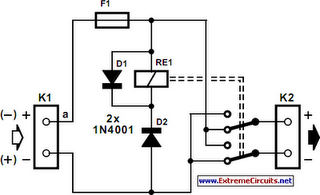Home » Circuits
Polarity Reverser
There are systems in which it is imperative that the supply voltage of, say, a motor, always has the correct polarity. It is, of course, possible to use a bridge rectifier for this, but if large currents are involved, this is not always possible. This may be because large voltage drops across diodes result in appreciable heat dissipation, or that the peak current exceeds the current rating of a diode. Fortunately, a good, inexpensive mechanical rectifier may be constructed with the aid of a relay. In the diagram, the supply voltage is applied to K1, while the motor that needs a supply with correct polarity is linked to K2. Provided fuse F1 is intact, a positive potential at terminal a of K1 will be applied to the positive terminal of K2. Diode D2 prevents the relay being energized.Circuit diagram:

When the polarity at K1 is reversed, the relay will be energized via D2. The relay contacts then interchange the connections to the terminals of K2 to ensure that the previous polarity of the supply to the load is retained. Diode D1 is a freewheeling diode for the relay coil. The type of relay to be used depends on the requisite operating voltage and the current through its contacts. Other parts of the circuit are not critical. It stands to reason that the circuit is not suitable for use with a small battery, since the relay coil draws a fairly large current.
Author: K. Lorenz
Copyright: Elektor Electronics
Copyright: Elektor Electronics
